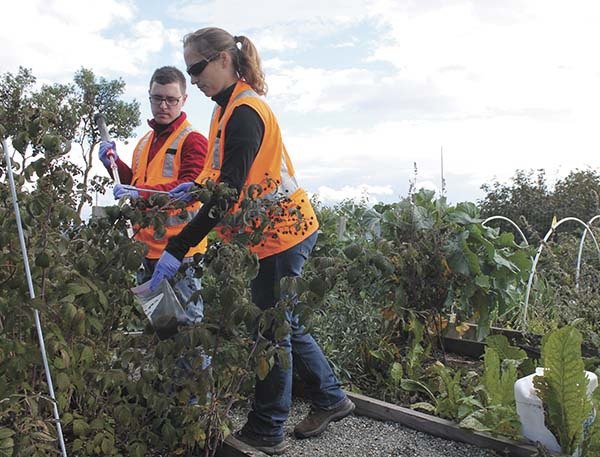On Monday afternoon, Valencia Lund looked over her property at the southern end of Maury Island as a half-dozen people in brightly colored vests worked in her yard and garden.
The state workers weren’t doing landscaping, but collecting small soil samples to be sent to a lab in Tacoma and tested for arsenic.
Lund is one of 700 Vashon and Maury homeowners identified as eligible for a publicly funded yard testing and cleanup program that kicked off this month. And if arsenic levels in her yard are high, she could receive a foot of new topsoil, part of the state Department of Ecology’s (DOE) neighborhood-by-neighborhood effort to find and remove arsenic-laced soil from those areas most contaminated by the historic Asarco plume. Testing will go through next year, and yard cleanup will begin as soon as next summer.
“We’re really encouraging people to participate,” said Hannah Aoyagi, an outreach and education specialist at DOE’s Toxics Cleanup Program. “This is probably the one opportunity we’ll have to go out and systemically sample all these homes.”
State funding for the massive cleanup, comes from a settlement with Asarco, a Ruston-based copper smelter, made when it filed for bankruptcy in 2005. The state received $188 million in settlement funds and expects to spend about $64 million of that on its yard cleanup program, which will also take place in north Tacoma.
For now, the state program is targeting two swaths of the island where previous testing has shown that parcels are most likely to contain high levels of arsenic — the southern third of Maury Island (an area that extends as far north as S.W. 260th Street) and the southern tip of Vashon.
A map put out by the DOE last year shows that another area that includes the rest of Maury Island and a large portion of Vashon could contain high arsenic levels as well, but Aoyagi said the state needs to do more soil sampling there to better understand the extent of the contamination, something that won’t happen for another year or two. Homeowners in those areas won’t be contacted by the state for now, but can request that sampling be done and could be eligible for cleanup in the future.
“There’s a pretty large area we marked as needing more sampling,” Aoyagi said. “We don’t want to rule people out of the program, but we know where we need to go first and what the priority is.”
Letters about the yard sampling and cleanup program have gone out to about 350 residences, said Amy Hargrove, a coordinator with DOE’s Yard Cleanup Program. The state will soon mail letters to the remaining 350 homes, and DOE representatives will go door-to-door to talk about the program as well.
Those who opt to participate will have up to four areas of their property that are frequently used — yards, footpaths, gardens or playgrounds — tested for arsenic, and soil with arsenic levels of over 90 parts per million will be eligible for the cleanup, Hargrove said. As soon as next summer, the state will remove the top 12 inches of soil in contaminated areas and replace it with fresh dirt, also replacing grass or other foliage removed in the process.
“Basically we’re trying to replace what people had before, within reason,” Aoyagi said.
The state has already performed such cleanups at some island parks and childcare centers and for years has run an educational program that encourages homeowners to use caution when dealing with soil.
Denise Katz, a real estate agent for Windermere, said she recently heard from a client in Dockton who received a letter about the yard cleanup program and was concerned about how it may impact her ability to sell her home.
Katz, who then consulted two attorneys on the matter, said the letter would have to be disclosed in any real estate transaction, as would any information obtained through testing. At the same time, she said, she didn’t think sellers should be concerned. Soil contamination on Vashon and Maury has been known of for decades, she said, and agents haven’t seen it affect home sales.
“The bottom line is testing is probably the right thing to do because it would make sense,” Katz said.
Emma Amiad, another local real estate agent, concurred.
“We’ve known about arsenic since the 60s, and it didn’t affect real estate issues,” she said.
Amiad frequently talks with clients about the pollution from Asarco, she said, and encourages them to have soil testing done if they have concerns. At the same time, she said, she encourages them to research the issue, as she believes there’s no proof that the arsenic-laced soil poses a health risk.
So far, she said, higher rates of illness haven’t shown up on Vashon or in the 1,000-square-mile area identified as having some level of contamination from the Asarco smelter’s toxic plume.
“I’m not saying arsenic isn’t a problem. We all sort of agree this is probably a problem, but we have no science,” she said.
Aoyagi said that while no local health trends have been tied to the Asarco contamination, the state takes the issue seriously and uses conservative data to estimate risk. Long-term exposure to arsenic and lead — which is also found in contaminated soil — is known to increase the risk for certain types of cancer, heart disease, diabetes and other chronic health problems. Officials believe the risk would be highest for those who are frequently exposed to and ingest soil, primarily children.
“It’s a really difficult message,” Aoyagi said.
As for Lund, on Maury, she said she’ll go for the free cleanup if her property qualifies, but she’s known about the potential pollution for years and hasn’t been concerned. She is careful to wash her hands after she works in the yard, something she noted that she would do anyway, and when she and her husband planted a garden, they created raised beds with fresh soil.
“You work around it,” she said.



